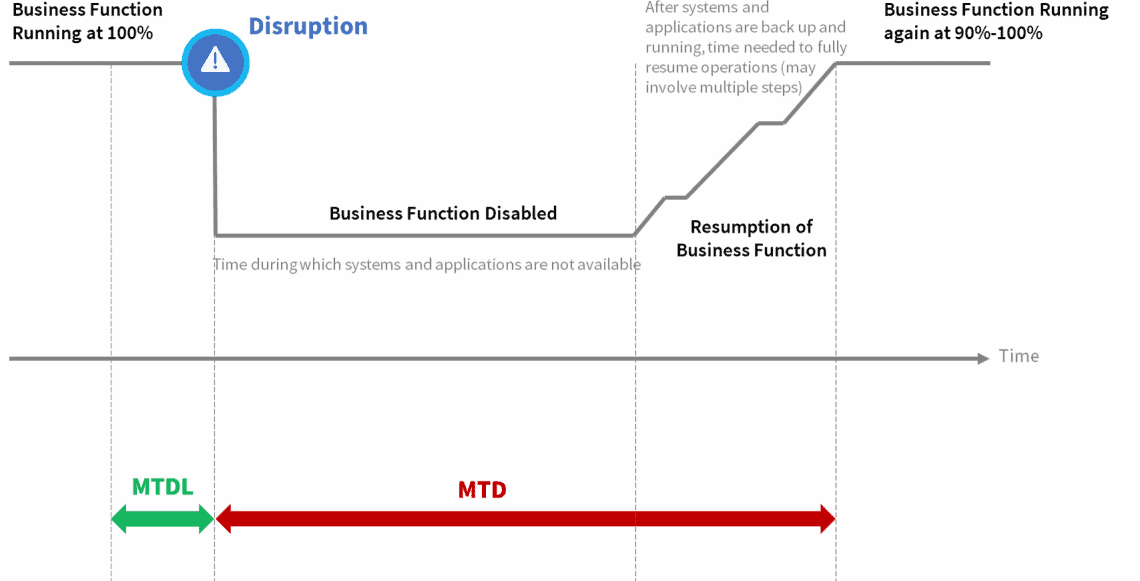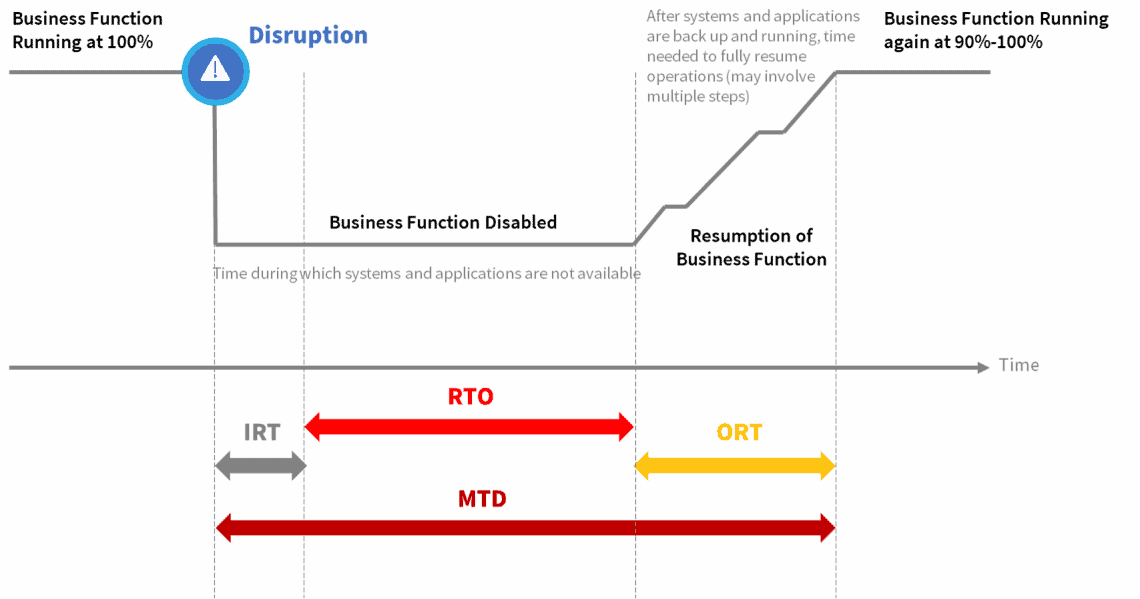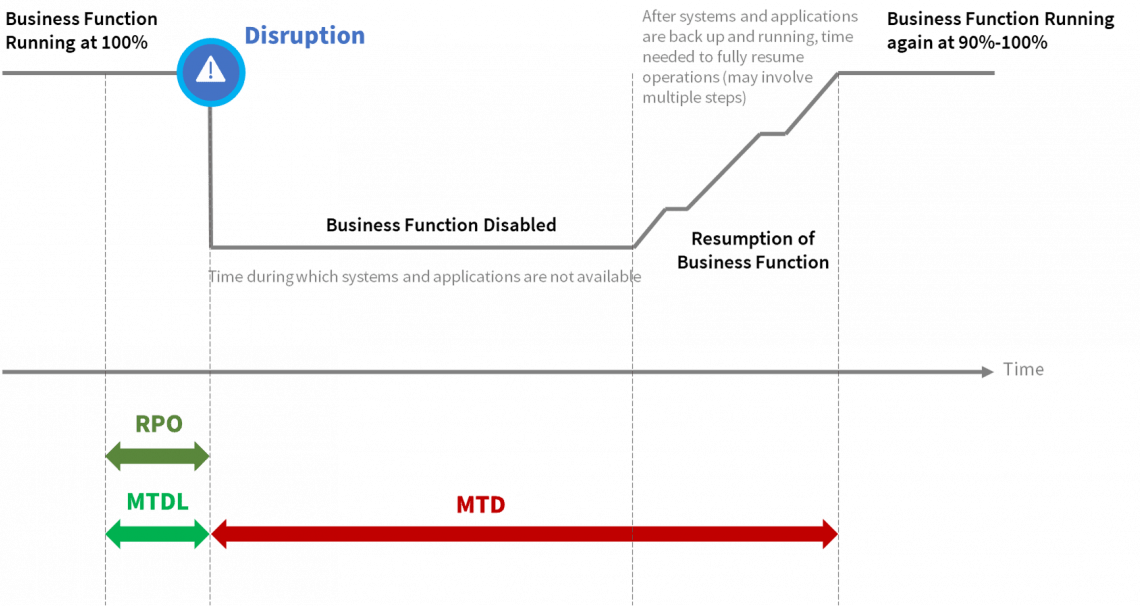Maximum Tolerable Downtime (MTD) and Maximum Tolerable Data Loss (MTDL): Differences and Considerations
A-to-Zerto Glossary of Terms
Overview
Maximum tolerable downtime (MTD) and maximum tolerable data loss (MTDL) are two of the most important metrics of any business continuity plan. Respectively, they describe recovery time for business processes and operations and data loss in the event of a disaster (see Figure 1). For any given business process, staying within these two target metrics is key to business continuity. When these metrics aren’t met, a business is likely to suffer negative impacts to operability, revenue, and brand reputation. Comprehensive and industry-leading solutions are required to define and achieve MTDs and MTDLs that defend against loss.
Related Topics
What Is the Difference between MTD and MDTL ?
MTD and MTDL are both service level agreement (SLA) metrics that establish parameters for maintaining business continuity. Measured in units of time, they express the limits of disruption a business can endure before incurring losses. The business continuity management team will always try to find ways to lower MTD and MTDL through mitigation or process management.

Figure 1
- Maximum tolerable downtime (also referred to as maximum allowable downtime) is the longest downtime an organization can tolerate before facing negative consequences to operability, revenue, brand reputation, and more. In business continuity planning, a business impact analysis (BIA) will most likely define the MTD for critical business processes. This directly informs the SLA associated with a particular business process.
- Maximum tolerable data loss represents the maximum amount of data or transactions the business can afford to lose over a specific business process or function before facing negative consequences. The disaster recovery (DR) team uses MTDL to determine the RPO required to meet the SLA.
Risk Assessment, BIA, SLA, RTO and RPO: What's the Link? MTD and MTDL
SLA in Business Continuity
What Are the Components of MTD?
To calculate MTD, business continuity planning teams simply sum three metrics: incident response time (IRT), recovery time objective (RTO), and operational resumption time (ORT). These three phases, as shown in figure 2, are necessary to restore acceptable business operation following a disruption.
Ultimately, for any critical business process or function, an organization wants to get the sum of its IRT, RTO and ORT to be lower than its identified MTD.

Figure 2
1) Incident Response Time (IRT)
IRT represents the elapsed time from when a disruption occurs to when a disaster is declared and the DR plan activated.
For minor to moderate disruptions, the incident response team alone might be able to manage the incident, in which case there would be no DR response. For more severe disruptions, DR teams execute the DR plan.
The speed at which a disruption is detected will depend on the effectiveness of the monitoring or alert system. The speed of disruption assessment and DR plan activation (if applicable) depends on staff training and the incident response workflows involved.
2) Recovery Time Objective (RTO)
RTO measures the time required to resume operating the technology infrastructure at a normal or acceptable level. During DR planning, the DR team establishes a target RTO based on MTD. However, it’s not easy to translate an RTO at a business process level into RTOs at system and application levels. RTO and RPO: Differences and Considerations describes this process in more detail.
If, despite the DR team’s efforts, RTO is, or is expected to be exceeded during this phase, the business continuity plan may trigger a crisis management plan.
3) Operational Resumption Time (ORT)
ORT describes all other activities needed to restore business functionality after IT systems are up and running. In the event of a hurricane, for example, these activities could include employees returning to the office or connecting remotely and restoration of interfaces among people involved in running the business function. But they can also include tasks required to get applications running properly, such as re-entry or re-sync of data.
Comprehensive understanding of a business process is required to accurately estimate ORT and whether it can be met during a disruption. This is a key aspect of BIA. To be diligent and plan well, an organization must be serious about dedicating resources to and investing in its business continuity planning process.
What Are the Components of MTDL?
MTDL is directly linked to RPO, as shown in Figure 3. Once an organization evaluates its finances and operations to establish the maximum amount of data loss it can accept, the DR team can solve for meeting MTDL based on its current resources and technology. They can also explore new solutions that could deliver or exceed MTDL with similar or lower overhead requirements.

Figure 3
Recovery Time Objective (RTO) and Recovery Point Objective (RPO): Differences and Considerations
Meet the Most Stringent Business Continuity SLAs with Zerto
When businesses aren’t prepared for disruptions or haven’t thoroughly evaluated their MTDs and MTDLs, their operations and revenue are in jeopardy. Unplanned disruptions do not affect just IT operations—they have a domino effect on an entire organization. As a BIA will show, an organization’s reliance on technology to maintain operations and visibility steadily increases as it grows, and meeting SLA metrics is critical to safeguarding continued growth.
Zerto, a Hewlett Packard Enterprise company, protects growth and operational integrity through an always-on experience that transforms business-as-usual, helping organizations realize their innovation goals. It uses industry-leading protection —continuous data protection, or CDP— to ensure that IT systems remain resilient through identified potential disruptions and deliver RPOs and RTOs that meet the most stringent SLAs, featuring the shortest MTDs and MTDLs. By providing the best RPOs and RTOs at scale in the market, Zerto enables organizations to meet SLA metrics that support true business continuity and future success.
Zerto Solution Overview
Zerto Continuous Data Protection vs Competition
Other Resources
LATEST FROM ZERTO SEE ALL
Fastest RTOs and RPOs in the Industry with Zerto CDP
Discover and access content from Zerto and 3rd parties (IDC, Gartner, ESG, etc.) related to continuous data protection (CDP).
Buisness Continuity Plan (BCP) vs. Disaster Recovery Plan (DRP): What Are the Key Differences?
Explore the differences between business continuity and disaster recovery plans, and when, how, and in what scenarios they are most effective.
Essential Guide: Business Continuity
Get everything, from the definition of business continuity and its related plans, to the description of the planning involved in establishing the business continuity plan, right down to its management.
What is Zerto?
Learn about Zerto and how it can help you solve your data protection and recovery challenges.